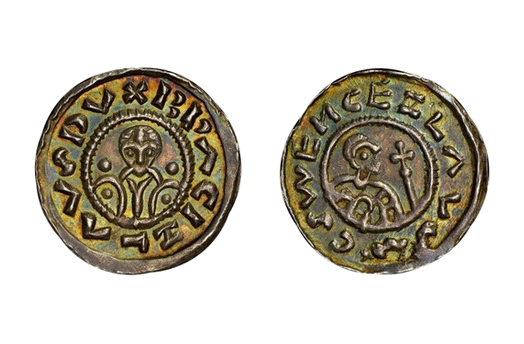
about ancient nomos
Ancient Nomos Art is a museum of galleries exhibiting ancient coins and ancient mint maps. The coin gallery displays the diverse art and history of hand-crafted ancient Greek, Roman, Byzantine, Persian and Medieval coinage. The ancient mints mapping gallery features Greek, Roman, Byzantine, Asia Minor and Medieval mint city regions and territories. Visitor's are welcome to explore, study and enjoy Ancient Nomos Art.

Medieval Prague – 1050 AD
Bretislav I
From Ancient Galleries

Obverse: Latin legend: BRΛCIZLΛVS DVX, facing bust of Bretislav I; two pellets are flanking his head.
Reverse: Latin legend: SCS WEИCEZLΛVS, bust of St. Wenceslaus facing right; scepter to his right.
LEGEND
Obv: BRΛCIZLΛVS DVX, facing bust of Bretislav I; two pellets flanking his head. Rev: SCS WEИCEZLΛVS, bust of St. Wenceslaus facing right; scepter to right.
The first true medieval “Czech coinage” occurred under Prince Oldrich, shortly after 1012 AD. The Přemysl denarii stopped copying foreign coin designs, in terms of Anglo or Carolingian motifs, in the first half of the 11th century, when purely domestic, original motifs appeared for the first time on the Bohemia (Czech) denarii of princes Oldřich (1012 – 1033, 1034) and Břetislav I (1034 – 1055). In particular, the name and later the image of St. Wenceslas as the provincial patron emphasizes the influence of domestic culture and the emerging cult of St. Wenceslas. In 1050, Prince Břetislav I embarked on the first comprehensive coinage reform. The previous denarius was a silver coin with a diameter of about 20 mm and a weight of more than 1 g. They were minted in the number of 240 from the Carolinian pound of approx. 408 g. Břetislav I changed both the basic weight unit intended for the minting of denarius, as well as the number of pieces, weight and diameter coins. The default unit of weight was the Nordic mark – hryvnia weighing about 210 g, from which approx. 200 denars were minted with an average weight of 0.9 g and a diameter of 16 mm. Since Břetislav’s reform, we have been talking about the so-called small strižek denarii (strižek = a disc of metal ready for minting). The mint reform of 1050 also affected Moravia, where denarii of a smaller denomination were then minted (the first Moravian coins were minted under the influence of the Czech minting of Břetislav I in about the 1920s). At the same time, the production of Moravian denars is increasing, which is related to the division of Moravia into 3 territorial administrative units: the principalities of Olomouc, Brno and Znojmo. The successors of Břetislav I respect his reform and adjust their coins according to it. On the denarii of the first Czech king Vratislav II. (1061 – 1092) from the years 1086 – 1092 we can also see for the first time a depiction of the royal crown that adorns the monarch’s head.
DOCUMENTATION
Value: Denar. Metal: AR Silver. Weight: +/-1.00 gram. Mint: Praha (Prague) mint. Date: Struck 1050-55 AD.
Attribution: Grierson, Coins of Medieval Europe 158; Freynas B8.14; Cach 322; Smerda 153; Donebauer 283. Photo courtesy NGC,The Historical Scholar Collection, Part IV.
Legend, Documentation and Attribution
